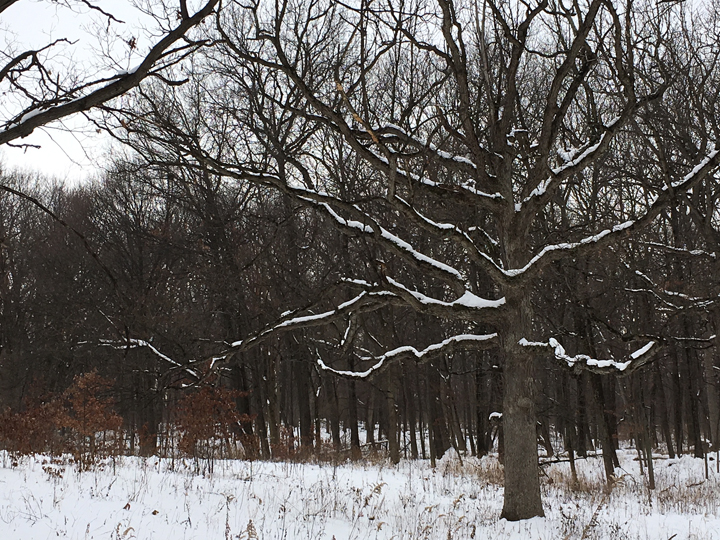
We’re having some character-building weather in Chicago. The thermometer got all the way up to zero today (Fahrenheit—that’s 17.5 below zero for you centigrade folks). I was bumbling down a sidewalk wearing layers of leggings, multiple socks, gloves within mittens, and so much headgear I could hardly peer out. I passed a nonchalant tree, standing with its branches bare and dormant, and I felt like an inferior being. Trees have this cold thing figured out.
The tree species that are native to cold places like the Midwest—oaks and beeches, sugar maples and hackberries—don’t have tender parts like ears or noses or fingertips that need to be protected from the cold.
A tree discards all its tender parts—its leaves—in the fall. It drains whatever might freeze, mostly sugars and the water they’re dissolved in, down into its roots, safe under the insulating soil. It wraps its branches in bark. It covers the leaf and flower buds at the tips of its twigs with armor scales to seal out the cold. Then it goes dormant and simply waits for spring. It has nothing to fear from the cold.
Plants that didn’t evolve in the cold, or that can’t go dormant fast enough when cold weather hits in autumn, do have serious damage to fear. When the water in green, tender plant cells freezes, it turns to ice crystals, sharp shards that slice open the cell walls. The water drains out and the cells die. Water loss is what actually kills plant tissues in winter.
A greenhouse is the horticultural equivalent of my layers of leggings. It seals a warm air around the plants so the water in their cells stays liquid. Of course the air has to be warm to begin with. At this time of year, when the days are so short, the sun doesn’t do much to overcome the cold, so a conservatory with growing plants will need supplemental heating as well as lighting.
The plants that do best in greenhouses are tropical species that don’t have a winter dormant period. In their native places, such as rain forests, they likely slow their growth during an annual dry season, but that kind of dormancy is a lot more subtle than dropping all your leaves at once to get ready for winter.
Midwestern plants, and most plants native to places with cold winters, actually need the cold. They won’t bloom if they don’t go through a spell of winter dormancy. That’s one reason a greenhouse is not a good year-round home for temperate-zone plants: They need the seasons.
However, it seems to me there’s no reason to go overboard. The trees may need cold, but they probably don’t really need 44 degrees below zero (Fahrenheit), which is how cold it got in Hettinger, North Dakota, on New Year’s Eve. I’m sure zero degrees is plenty cold enough. It could even warm all the way up to 20 degrees at night, I bet, and the trees would stay dormant. They’d still be safe and happy and I could shed a few layers of clothes, which would make me happier too.










